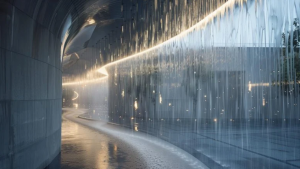First Published in
The Israeli designer Dror Benshetrit sits behind a massive wooden desk in a sparse corner office of his sixth floor studio in the heart of New York City’s garment district. A slim laptop is barely noticeable off to the corner and a wire-bound sketchbook lays open before him. It is clear that this handsome and well-dressed man is still a man who works with his hands. The only other room in the open-plan office is the woodshop, a space pilled high with signs of productivity.
Videos on the studio’s Vimeo feed depict Benshetrit in dark coveralls showing without words the design of his ideas. In fact, he often finds it frustrating to try to describe his work with words and stories, and relies instead on the communicative power of abstraction to evoke the qualities of the objects themselves. Calling upon the power of artistry to move a viewer, Benshetrit proposes modern dance as a fitting analogy for his approach to aesthetically luxurious design. There is a sparkle in his eyes as he relates that moment when he first saw his design process reflected in another discipline: Being blown away by the potency of meaning related through form and motion alone while watching the Israeli dance company Batsheva perform in New York.
As in dance, Studio Dror’s projects would not be possible without a huge host of collaborators, few of whom are actually viewable from the stage. With his slew of in-house and out-sourced experts, Benshetrit plays the part of inspired choreographer. Armed with a vision, he selects a company of performers furnished with laptops instead of dance shoes to bring the designs he imagines to life.
Something of the bodily movement in dance manifests itself in his work too. In the Cappellini Peacock Chair, for example, the tension of compressed felt that holds its form, without the need for sewing or upholstery techniques, seems to evoke the same formal anticipation of a taught muscle flexed for motion. Or the Vase of Phases produced by Rosenthal: A ceramic study of gesture, depicting the act of breaking caught in sculptural stillness, like the suspense of a breath caught on an inhale. Once you start to look for it, the physical metaphor of the body is everywhere in Benshetrit’s work. Even in the newest architectural ventures there is something reflexively somatic in how the spaces are designed to transform.
Now under construction off the coast of Abu Dhabi, Nurai Island is an abstraction of Benshetrit’s three-dimensional thinking in architecture. His plan for the island’s development peels away at and moulds the surface of the land into being, revealing a luxury resort within its lush topography. In the bay, villas are suspended over the water like gleaming chandeliers, increasing the guest’s proximity to nature while balancing the maximum in material comforts.
After all, movement isn’t the only tool to understanding his portfolio: Before becoming a designer, Benshetrit was an abstract painter. Pulling from these early visual explorations, he consciously composes his designs to evoke the intangibility of meaning. His painterly approach conveys an ethos of feeling in his work; the art direction he produced for Bentley actually brings the sound of human breath to the crisp seal of a car door being opened. This distinctly multi-sensorial approach to design is something Benshetrit honed during the time he spent at the Design Academy Eindhoven, a school known for its creatively multidisciplinary methodology.
Another commission from the Abu Dhabi-based Zaya corporation behind Nurai, gave Benshetrit the opportunity to develop his concept for the Porto Dubai Peninsula. His proposal calls for the round spit of land to be sliced like a cake, bringing something of the awareness of product design to the planning of a residential development. These long skinny slices, shrouded in greenery, protract a sense of solitude along their lengths, cleverly allowing each plot its own private beachfront view. The buildings frame the space on a human scale and feel more like books on a coffee table than three storey constructions.
Not as much focused on the technical aspects of building (he relies upon a cadre of experts for this) Benshetrit’s multidisciplinary approach allows him to consider the user’s experience in a new way. For Benshetrit, just as architects are becoming more familiar with designing furniture, contemporary architecture is becoming more akin to the collaborative practice of product design. For the studio it has been a relatively natural transition in the evolution of their work. And unlike so many architectural firms practicing today, Studio Dror has never entered an architectural competition. In fact, Benshetrit was commissioned and approached directly by the client for all nine of the buildings they have in development.
Studio Dror’s newest project, QuaDror, launched during February at the Design Indaba Conference in Cape Town. A system of interlocking metal “knuckles” and “trestles” that exhibit an unparalleled tensile strength and structural stability for the astonishingly small amount of material used, QuaDror is deployable in anything from furniture to emergency housing. Realising the immense potential of the system, QuaDror has been announced as an open call for collaborations with their “co-creators” in design and architecture. Asking for proposals from individuals and humanitarian groups around the world, Benshetrit seeks to partner with a community of people who are united by their shared vision of sociological and ecological wellbeing through design. Already, just weeks later, the first QuaDror Homes have been announced in Sierra Leone and Brazil to be constructed by 2012, and more opportunities keep coming.
Initially inspired by his own design of the Floor Chandelier for Swarovski, the QuaDror geometry can be found all over the Studio Dror portfolio in the form of prototypes. The collapsible system envelops a LED bulb for Volume.MGX in one image and then the entirety of the Guggenheim Museum in another. Dividing the urban grid as a concrete sound barrier, the QuaDror simultaneously illustrates its function as a collapsible system for pre-fabricated housing in renderings of the QD 01-06 dwelling. It is this range of design applications within one system of thinking that best illustrates why Benshetrit calls himself a multidisciplinary designer.
Benshetrit chooses to work only with clients who share what he calls his “but why?” approach to innovation. By questioning assumptions, he finds clarity in his design work. His examination of the design process reveals a kind of simplicity, an ease of form rendered visible through a process of increasing complexity, like a bright spotlight shone through a fog to expose the soft arc of a dancer’s body paused to catch its breath. Behind his desk in New York, a knee bandaged from a recent snowboarding accident, Dror Benshetrit embraces the spirit of inquisitive exploration in both his life and design practice.
Amelia Black is a recent graduate of the Design Criticism Master programme, D-Crit in New York City. As a designer she uses research, writing and curation as tools to craft experiences about design and thinking.






















